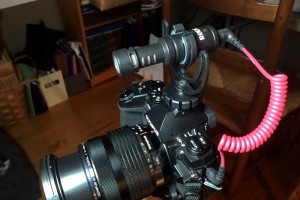Over the past several weeks, I have been exploring the process of recording videos with my cameras again. I have been writing about my lighting, audio, shooting setups, and the like, but not the cameras I am using. (http://www.infotor.com/blog/category/video-2/) It has been several years since I started experimenting with recording videos. Three years ago I was using my Canon 60D, which has an articulating LCD that swings out to the side of the camera body and can be turned to face the subject of the video. In that case, I was the subject. Therefore, it was handy for me to be able to see how I was positioned in the frame I was capturing in the recording. The new Olympus OM-D E-M5 Mark II has a similar LCD setup but my E-M1 does not. However, unlike the Canon 60D, my E-M1 does have built-in wi-fi. Through the wi-if connection from my iPhone or iPad to the E-M1, I can control the camera remotely and view on my iPhone or iPad screen what the camera is seeing through its lens.
Being able to monitor what the E-M1 is recording on my iPad Mini 3 is actually better thandoing it on the 60D's small 3" LCD screen! So is, for that matter, the screen on my iPhone 6 that I'm holding right in front of me in my hand. Since I am now often using the iPad Mini as a teleprompter, I use the iPhone as my remote controller for the E-M1. However, if I do a video where I am not using the teleprompter, I can use my iPad Mini and that is excellent because of its larger screen.
So far, I've only used my E-M1 to record myself, controlling it from my iPhone. Though the screen displayed on the free OI.Share app is reasonably full-featured, I have discovered a few things that frustrate me. I use this app to help me set up the recording. I can view myself in the frame and make sure I'm not cutting off my head or that things are not appearing in the frame that I don't want to be in the video. Things such as lights I'm using, my VideoMicro mic, etc. It also lets me see what the scene will look like to those who view the final video. In fact, this caused me to finally clean off all the junk I had let pile up on the shelves that are behind me when I video in my office! Just as important, though, is the exposure of the scene. And this is where my frustration begins.
The new E-M1 firmware 4.0 brings 24 frames per second recording to the E-M1. This is great as 24 fps is a standard in the US. The rule of thumb when recording video on traditional still cameras is to use a shutter speed that is close to double the frame rate. That's 48 so a shutter speed of 1/50 is what I use. I don’t want that to change. That leaves me with aperture and ISO to expose the scene properly. I was frustrated because I could not change ISO in Video Mode using the OI.Share app. I would have to switch the app to Manual Mode to change the ISO, then switch back to Video Mode to see how the new ISO affected the exposure. I solved this frustration by setting the shooting mode for movies to “Shutter-Priority” and ISO to Auto. Now, in Video Mode, I set the shutter speed to 1/50 and the ISO and aperture values adjust to expose the scene “correctly.” I can make an exposure compensation adjustment using the app, at least. However, if I want to use a wide open aperture for a shallow depth-of-field, but still want to keep the shutter speed at 1/50, I can’t do that without going into Manual Mode and back to my frustration.
Back to the good things abut using the E-M1. It has an external microphone-in port. This means I can plug in an external mic to record much better sound pick-up than the E-M1’s internal mic can capture. This is important because, though I can record good audio using an external recorder, that means I have to sync up the audio tracks of the camera with that of the recorder in post-production. Though this is not difficult, it is still one more step that can be eliminated by recording good quality audio directly to the camera.
All in all, video recording with my Olympus OM-D E-M1 has been very positive. As I do more videos, I expect to get better at it and am happy to know that I have a reliable camera that is going to produce quality footage that I can work with to put together quality videos.
NOTE: Check out Andrew Reid's article from almost two years ago where he talks about the E-M1 being "better than expected for video." Since the Firmware 4.0 update came out, Reid updated his comments on using the E-M1 as a video camera.
If you would be interested in virtual tutoring sessions using either Skype or Google Hangouts, please drop me and e-mail or leave a private message to me on Facebook or Google+.
Please leave me questions or comments on my Facebook page (https://www.facebook.com/billbooz) or on Google+ (http://plus.google.com/+BillBooz). I look forward to interacting with you!
Check out my free eBook on Mastering Your Camera's Priority Modes: http://www.infotor.com/ebooks. Download and enjoy!
I am available to do one-on-one tutoring or small group lessons designed to meet YOUR needs and what you want to learn in the area of photography, using flashes, or the use of Apple products and software. Give yourself the gift of learning: http://www.infotor.com/photoclasses! And check out my tutoring bundle: http://www.infotor.com/photoclasses/tutoringbundle.php as well. A PDF of my brochure is at http://www.infotor.com/photoclasses/brochures/WHBI_2015-16Brochure.pdf.


